A few weeks ago, Luisa wrote about Oma and Bella, a film about two women--best friends, Holocaust survivors, splendid home cooks--and their life in the kitchen. Regina and Bella (the filmmaker, Alexa Karolinski, is Regina's granddaughter, making Regina her Oma) live together in Berlin and spend their days in bright kitchen smocks hovering over simmering pots of borscht, rolling up stuffed, oversized cabbage leaves, and filling tins to the brim with sparkling cream-cheese cookies. The film, though about their lives now, is permeated with their past. The food that they prepare day-to-day is the same food they grew up eating. Now, I don't have any personal connection to any of this--to that very dark part of history, to post-war Germany, to the culture and traditions that survive with Regina and Bella. But you certainly don't need to to appreciate the film or to want to cook everything from the beautiful little book of recipes that Alexa has put together.
What I find most remarkable about Regina and Bella's cooking is that it is all pieced together from childhood memory. They alone from their respective families survived the camps, and they'd been too young at the time to learn to cook. So, after the war, they taught themselves from the flavours they remembered. And this is the same food that they cook today, that connects them to a past of which there are otherwise very few tangible traces. (In the film, Regina and Bella tell us that any survivors who were able to save family photos were very lucky.) So leafing through the cookbook, having the sweet smell of slow-roasted onions fill my kitchen (these onions are at the heart of Regina and Bella's cooking), feel to me like something of a privilege. I feel terribly lucky to be able to cook this food at all, and I am so glad that Alexa took on the project of turning their handfuls into half-cups so that we might all share in it.
Regina and Bella are firm believers in keeping their freezer well-stocked--as in, they are always prepared to feed a serious crowd with almost no notice. I really admire that. It always feels reassuring to have at least a few goodies stashed away. My own freezer stock was not (and still isn't) nearly as impressive (chicken stock, pork stock, gelatin purée, ground turkey, two sausages, marrow bones), so when my copy of the cookbook arrived in the mail, I decided to start with Regina and Bella's pierogis, with the hope of adding to it.
But I'm afraid that my freezer stock of pierogis is already nearly gone. I made a double batch, hoping that the pierogis would turn out well. But really, I should have made a quadruple batch at the very least. These pierogis are so, so good. The filling is super simple, just onion and potato. You cook down diced onions on gentle heat to a golden, sticky mass. This can take some time--over an hour in my case--but the onions don't need your undivided attention. And in the interim, you can also boil and mash a few potatoes for the filling and pull together the pierogi dough. The dough, by the way, isn't at all fussy. It can get a little dry once rolled out if you don't work quickly enough, but that is easily remedied with moistened fingertips. It will hold shut during cooking with some good, firm pinches and doesn't suffer after being handled a lot. Admittedly, with the onions to cook down, the dough to prepare, and the assembly, making these pierogis can feel like quite the production. But they are definitely worthwhile, especially if you make a big batch to stash away.
The cookbook suggests that you serve your pierogis with meatballs. We ate ours alongside braised red cabbage spiked with apple-cider vinegar and caraway seed. Alexa also says in the book that her Oma has been known to chase her pierogis with homemade pickles and shots of vodka. I just don't have the constitution for that sort of thing, but what women Regina and Bella must be!
Potato and Onion Pierogi
Adapted from Oma & Bella, The Cookbook
Note: You may end up with a little extra filling--I had maybe a 1/4 cup leftover--but I wouldn't expect this to be much of a problem. Even cold out of the fridge a day later, it was very good.
FILLING:
2 large yellow onions
125 ml / 1/2 cup vegetable oil
700 g / 1 1/2 lb starchy potatoes (about 3 medium ones)
Salt and pepper to taste
DOUGH:
380 g / 3 cups all-purpose flour + more for dusting
125 ml / 1/2 cup water
2 large eggs
Large pinch of salt
TO FINISH:
Scallions or chives, thinly sliced
Sour cream
Finely dice the onion and fry it in the oil in a large, heavy-bottomed skillet on low to medium-low heat until dark-golden brown, about 1 hour. Meanwhile, peel and boil the potatoes in a large pot of salted water until tender, about 20-25 minutes, depending on the size of your potatoes. Drain the potatoes and return them to their pot with the heat on medium, then mash them (doing things this way will help to rid the potatoes of excess water). Remove the onions from the oil with a slotted spoon (don't toss the oil--save it to fry the pierogis in or for some other use) and combine them with the mashed potato in a large bowl. Season with salt and pepper to taste.
In a large bowl, mix the flour, water, eggs, and salt with a fork until a rough dough forms. Turn the dough out onto a clean surface and knead for 5 minutes as you would pasta dough, pushing the dough away from you across the work surface with your palms and then balling it up and repeating this, using flour as necessary to prevent the dough from sticking. Cover the dough with plastic wrap or an overturned bowl for 5-10 minutes to let the dough relax. Then roll out the dough until it is only a couple of millimetres thick, again using flour as needed (it helps to have a bench scraper handy and to use it lift the dough from your work surface occasionally to prevent sticking). Use the rim of water glass or a biscuit cutter about 3 inches in diameter to cut circles out of the dough.
On each circle, place a tablespoon of the potato filling. Fold the dough over itself to form a semi-circle and seal the edges with damp fingers, pinching firmly. Place finished pierogis on a flour- or cornmeal-dusted baking sheet. (Be sure to gather up the dough scraps and re-roll them for a second or even third round of pierogis. Just keep this remaining dough covered while you're busy with assembly.) At this point you can either freeze the pierogis on the baking sheet until firm and then seal them in a bag in the freezer for later use or proceed as follows.
Bring a medium-sized pot of salted water to a boil. Place the pierogis in the boiling water. When they float to the surface, they are ready. Drain in a colander.
In a skillet over medium heat, fry the cooked pierogis, a few minutes per side, until golden brown. Serve hot with scallions and sour cream.
Makes about 30 pierogis, enough for 4-6 people as part of a larger meal.

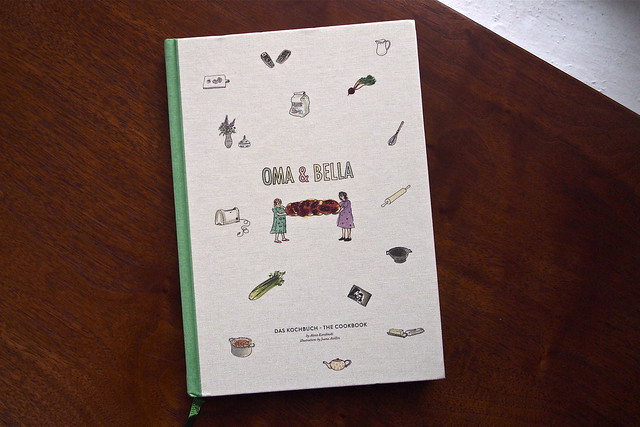

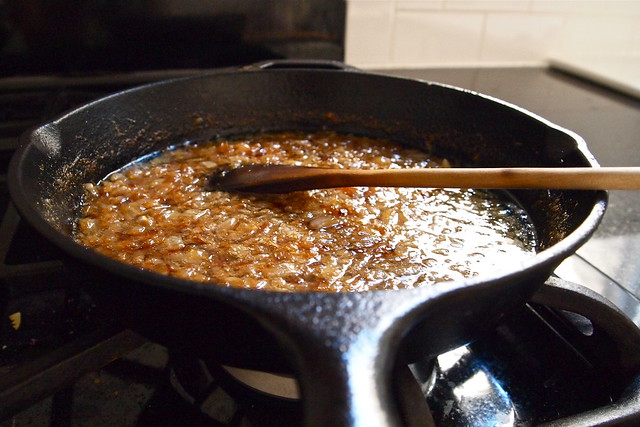
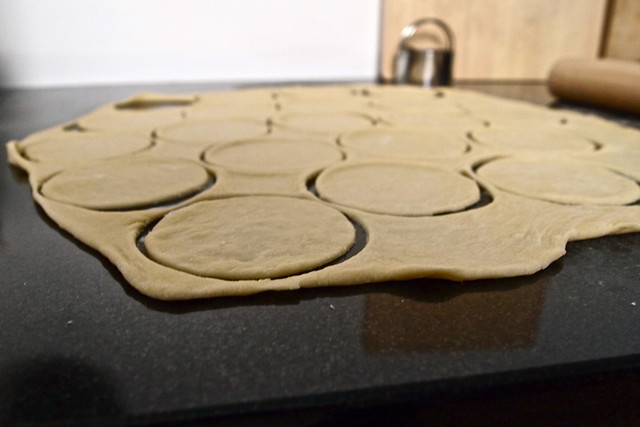

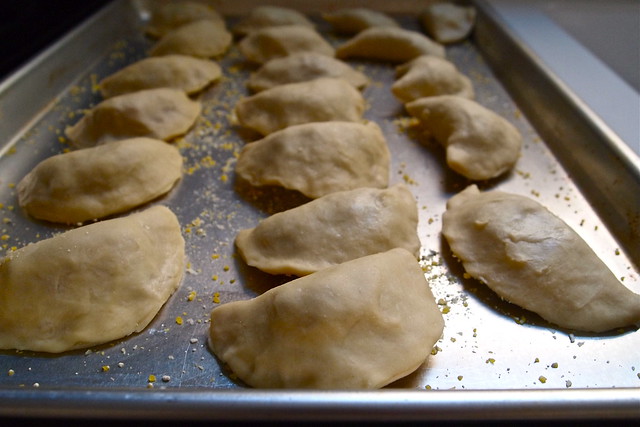
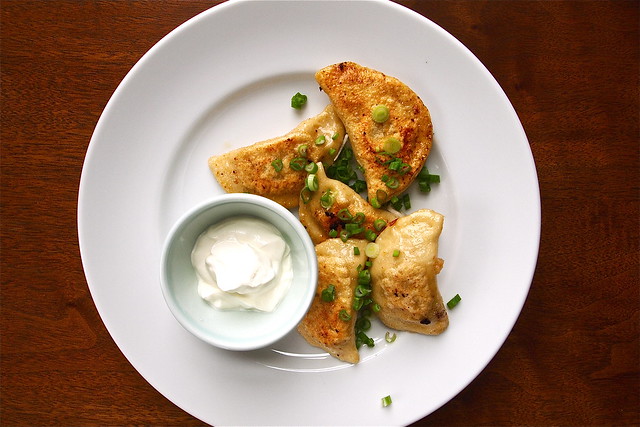
Such a lovely post! Going to have to get this cookbook - what a story!
ReplyDeleteThese look so wonderful Katie. Your freezer goodies sound impressive my dear. I have always dreamed of one day having a freezer big enough to store mountains of food so that I too, may entertain an amry or guests. One day!
ReplyDeleteI have been wanting to get my hands on Oma and Bella since Luisa posted about it---thanks for the push. Ben's grandmother is Latvian and we make pierogs, the eastern Europe version of pierogi, but they're a yeasted dough, filled with bacon and onions---really good. These are more my style, though. Thanks again, Katie. ---S
ReplyDeleteI'll have to look into these Latvian pierogis. They sound fantastic!
DeleteHow good do THESE look?! Pierogis are one of my partner's favorite dishes to make from his heritage. Before meeting him, they were new to me but have since become very popular with our family of six boys. I am anxious to try your method for preparing these. Congrats on an outstanding site as well! I am just getting started on a food blog and love seeing such great examples as yours.
ReplyDeleteMy apologies, I screwed up the URL with my name. This should be better.
DeleteI recently watched this movie and bought the cookbook too (it's definitely a gem), although I sadly haven't had time yet to cook from it. This post makes me want to forget about my to-do list and start slow-roasting some onions.
ReplyDeleteI also wanted to tell you that I love your blog. I only recently found it, but it really resonates with me. I'm also a graduate student (Russian literature) and my nights are filled with cookies, making syrupy pastries and feeding a starter (this is still a work in progress, but I'm optimistic).
Best of luck with both your Ph.D. and your culinary adventures! I look forward to reading more!
Katy, thanks for dropping by! Good luck with your starter--I didn't actually make my starter but received some from a friend, so good on you for doing it yourself!
DeleteI can't wait to cook more from Oma & Bella (the cheese blintzes are next on my list). But slow-roasted onions are really something special.
Hi again, Katie, I just thought I'd report that I finally cooked from Oma and Bella; I decided to start simple with the German Sugar Cookies and, although they didn't turn out to be quite as simple as I had anticipated (I had a rather hard time with the dough even after refrigerating it, and I definitely got nowhere near the 40 cookies the recipe promised), they were well worth the effort...They were definitely nothing like traditional cookies. Instead, they were like little crispy pie dough rounds with caramelized sugar. In short, nothing to scoff at. It also began to make sense why Oma and Bella suggested they be served with compote...
DeleteHappy cooking! I hope the blintzes turn out well; they may be next on my list, too.
Ooh, I was curious about those cookies. Crispy pie dough rounds sound amazing! I'll have to give them a try sometime, maybe when there's actual fruit to be had around here for compote...
DeleteOh my goodness, I'm so glad you've already cooked from the book and with such success! I have it sitting on the shelf over my computer and every time I sit down, my eye catches it and I remember I need to go make a list and get cooking. Those pierogs that Sarah mentions above sound delicious, too.
ReplyDeleteLuisa, I'm so glad that you wrote about Oma & Bella in the first place! It is a treasure. I hope you find the time to cook from it soon.
DeleteWhat a nice post. You really got me thinking by saying that you feel lucky to be able to experience the flavors that Oma and Bella remember from their childhood. Lately I've been thinking a lot about flavors from my own time growing up. It must be pretty special to be able to share in on those memories of others, especially when they represent such a unique time period that's becoming harder and harder to tap into.
ReplyDeleteBy the way, congratulations for being mentioned by Luisa in her "link love" page. When I saw her mention your blog, I got so proud, as if I had a personal investment by having been interested in your blog for the past year or so. ;)Your blog always has so much quality.
Yeah, I like to think of recipes like these as family heirlooms of the best kind, in part because eating with family is such a central part of childhood, and in part because they're eminently shareable--not the sort of heirloom that spends most of its time tucked away in a box!
DeleteAnd thanks, Amy, for believing and sticking around. I might have given up long ago were it not for your encouragement!
Just so you know, I've been thinking about these guys since you posted them last month. I am deep in end-of-the-semester despair and yet I can't stop thinking about these pierogi. Reminds me of a time when my family was driving by a church. My brother must have been 5 or so and someone read the church sign from the car as we drove past, which was advertising a pierogi dinner. My brother had never seen pierogi. Had certainly never eaten one. (We're Italian.) But he screamed and cried about wanting pierogi the rest of the way home. That's sort of how I feel right now. I'll have to wait a few weeks to make these guys. But luckily, I am not 5. Thank you for sharing this lovely, lovely recipe.
ReplyDeleteEmily, hang in there. I know the feeling. It's always precisely when you can't devote much time to cooking, it seems, that all your thoughts float towards being in the kitchen.
DeleteLovely post. I'm glad 101 Cookbooks guided me here. I hope to track down the film and the book, now. The story of how these two women recreated their culinary legacy is beautiful.
ReplyDeleteI think that filling one's freezer with goodness can be a long-term project, that's undermined by our enjoyment of that goodness along the way.
Just like my grandma used to make. She was a great cook & her perogis were my favorite. Happily she taught me how to make them. The smell, the taste of these and other dishes take me back in time. Mmmmm.
ReplyDelete